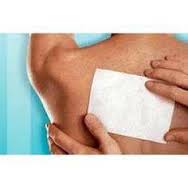Lidocaine Patch
The first lidocaine patch to enter the healthcare market was the LIDODERM patch. LIDODERM (lidocaine patch 5%) is comprised of an adhesive material containing 5% lidocaine, which is applied to a non-woven polyester felt backing and covered with a polyethylene terephthalate (PET) film release liner. The release liner is removed prior to application to the skin. The size of the patch is 10 cm x 14 cm.
Lidocaine is chemically designated as acetamide, 2-(diethylamino)-N-(2,6-dimethylphenyl), has an octanol: water partition ratio of 43 at pH 7.4, and has the following structure:
 |
Each adhesive patch contains 700 mg of lidocaine (50 mg per gram adhesive) in an aqueous base. It also contains the following inactive ingredients: dihydroxyaluminum aminoacetate, disodium edetate, gelatin, glycerin, kaolin, methylparaben, polyacrylic acid, polyvinyl alcohol, propylene glycol, propylparaben, sodium carboxymethylcellulose, sodium polyacrylate, Dsorbitol, tartaric acid, and urea.
Several lidocaine patch products have since entered the healthcare marketplace. While LIDODERM is a prescription lidocaine patch product many others are marketed over the counter (OTC). Some of these other products are:
- Solanpas
- Aspercreme with lidocaine
- Lidocaine Patch generic
Lidocaine Patch Approved Uses
USES: This medication is used to relieve nerve pain after shingles (infection with the herpes zoster virus). This type of pain is called post-herpetic neuralgia. Lidocaine helps to reduce sharp/burning/aching pain as well as discomfort caused by skin areas that are overly sensitive to touch. Lidocaine is in a class of medications called local anesthetics. It works by stopping nerves from sending pain signals.
How to use Lidocaine Patch:
Use Lidocaine Patch as directed by your doctor. Check the label on the medicine for exact dosing instructions.
- Lidocaine Patch is only to be used on intact, clean, dry skin. Do not apply Lidocaine Patch to broken, damaged, or inflamed skin.
- Wash your hands before and immediately after using Lidocaine Patch.
- Remove the liner on the patch. Apply the patch so that it covers the painful area. If the painful area is larger than the patch, apply the patch over the most painful area. Patches may also be cut into smaller sizes before removing the liner if desired. Be sure to discard the unused pieces of cut patches out of the reach of children and away from pets.
- If irritation or burning occurs when you apply the patch, remove it. Do not reapply any patches until the irritation stops.
- Patches may be worn for up to 12 hours within a 24-hour period as directed by your doctor. Clothing may be worn over the area where the patch is applied.
- After removing a patch, fold it in half with the sticky sides together. Discard the patch out of reach of children and away from pets. Do not apply another patch to the same area of skin for 12 hours.
- If you miss a dose of Lidocaine Patch, use the dose when you remember. Continue to use it as directed by your doctor. Do not use Lidocaine Patch for more than 12 hours in a 24-hour period. Do not use 2 doses sooner than 12 hours apart.
Ask your health care provider any questions you may have about how to use Lidocaine Patch.
This information is not intended as medical advice and should not replace medically supervised application. This information is for general reference only and should not be used to diagnose or treat any medical condition. Contact your license healthcare provider prior to using any topical lidocaine products.


